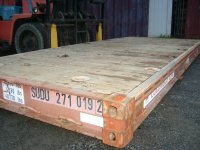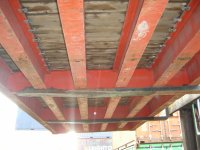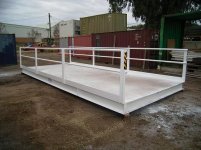I'm new to this site so I hope you all will bear with me. I've read through the recent threads and noticed that it's been a year or so since the last posting; I'm hoping to get some updated advice and info.
Anyway, I'm looking into building a bridge with (2) old 8' x 40' flatbed trailers @ $1400.00 each that I lucked into. They are hard to find. It's even harder to find local "bridge builders" who are familiar with using alternative (to wood, I beams, or concrete) materials; most are more comfortable installing culverts.
Meanwhile, I've had the opportunity to look at a bridge that crosses over a much larger stream to a wrecker service business. The owner did this project himself [using (2) 8' x 40's and (1) 8' x 45] and has routinely driven semi's across the bridge over the past 10 years. It seems very sturdy but the wood needs replacing; he milled his own oak and used 1"x6" decking on the more worn part and 2"x6" in other areas and said he should have used 2" thickness throughout.
He says he can pick up and deliver my flatbeds to my property, cut off the extraneous stuff, and winch them in place over my stream. He feels that it will take him and an assistant 3-4 hrs; he hasn't quoted me a price yet. He said I would need to "frame and pour the concrete".
I have heard that I can get very large concrete blocks at extremely reasonable prices. The concrete company pours excess concrete into the forms at each day's end. Obviously, there would be multiple pourings/dryings so I'm not sure if this impacts strength/lifespan.
My stream is approx 5 feet deep (although water's just about 6" now) and 20 feet wide so the flatbeds will extend approx 10 feet on each side of the stream's edges. We had a very wet season 2 years ago and many culverts were washed out across the street where my stream meets up with another stream. So, you can see that I'm pretty concerned that I don't do this project and then face a re-do when we have another wet year! I could probably do OK with just a single 8' width except I will need access across the stream for construction of the house, septic, well, etc. and imagine that the larger trucks will need more width than my car does.
The ground does freeze here but at this moment, I'm not sure what the frost level is.
I want to avoid disturbing (i.e digging) the soil around the stream/woodland as much as possible and try to limit heavy equipment soil compression also. I also would love to be able to balance functionality/safety/cost containment with appearance. I'm not sure how much "pretty" costs when you're building a bridge!
My goal is to act as my own contractor and get this project done well and within a reasonable budget. Obviously, I don't have a working knowledge of bridge building but I do want to educate myself and make sure that the folks that I hire will do the work correctly.
As always, I have to remind myself that this doesn't have to be a monster project and the mother of all bridges. I'm 55 years old, won't put a bunch of wear and tear on the bridge after the house is built, and am not really concerned that it last beyond my lifespan.
So, here are my questions:
1. What is the best way to support the ends of the flatbeds? Do I need to dig footings? If so, how deep, how wide; should they be continuous or is spaced OK? What about the large concrete blocks? How about just small concrete blocks laid above ground to set the edges on to keep the metal off the soil?
2. What would be the most economical, long-lasting way to deck the flatbeds? What's the best wood/dimensions. I'm sure concrete would be more expensive than wood; would it significantly reduce the load capability? If concrete is an option, what inexpensive material could be used to line the flatbed for a poured concrete deck? Alternatively, what about using gravel over some sort of permeable retaining material?
3. Any suggestions and instructions for railing?
4. How much money/sweat equity should I invest in scraping and painting the flatbed?
5. Any thoughts about a permanent installation of just one 8' x 40' flatbed (for my car access) and a temporary installation of the 2nd flatbed next to it until house construction is complete? I do need to keep in mind that in the event of a fire (heaven forbid), I might need a wider bridge for fire truck access.
I'd appreciate any thoughts and suggestions. I'm sure there are more issues I haven't even dreamt of yet.


